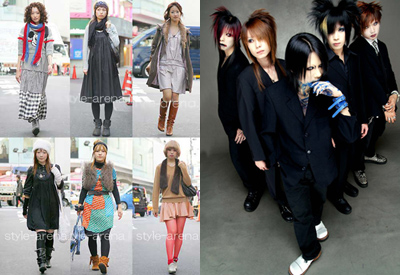Harajuku (原宿 “meadow lodging”) listen (help·info) is the common name for the area around Harajuku Station on the Yamanote Line in the Shibuya ward of Tokyo, Japan. The area is known internationally for its youth style and fashion. Harajuku street style is promoted in Japanese and international publications such as Fruits.
Location
Girls at Harajuku Station on a Sunday afternoon
Rockabilly dancers in Yoyogi Park
Harajuku is an area between Shinjuku and Shibuya. Local landmarks include the headquarters of NHK, Meiji Shrine, and Yoyogi Park.
The area has two main shopping streets, Omotesandō and Takeshita-dōri. The latter caters to youth fashions and has many small stores selling Gothic Lolita, visual kei, rockabilly, hip-hop, and punk outfits, in addition to fast food outlets and so forth.
In recent years Omotesandō has seen a rise in branches of expensive fashion stores such as Louis Vuitton, Chanel, and Prada. The avenue is sometimes referred to as “Tokyo’s Champs-Élysées”. Until 2004, one side of the avenue was occupied by the Dōjunkai Aoyama apāto, Bauhaus-inspired apartments built in 1927 after the 1923 Kantō earthquake. In 2006 the buildings were controversially destroyed by Mori Building and replaced with the “Omotesando Hills” shopping mall, designed by Tadao Ando.[5] The area known as “Ura-Hara” (back streets of Harajuku) is a center of Japanese fashion for younger people — brands such as A Bathing Ape and Undercover have shops in the area.
Subcultures
The term “Harajuku Girls” has been used by English-language media to describe teenagers dressed in any fashion style who are in the area of Harajuku. These girls may be members of various sub-cultures including Gothic Lolita, Ganguro, Gyaru, and Kogal. They may also be dressed as characters from an anime, movie, or manga (known as cosplay).
Three teens outside Harajuku Station cosplaying members of the band Himitsu Kessha Kodomo A.
In the 1980s large numbers of street performers and wildly dressed teens including takenoko-zoku (竹の子族, “bamboo-shoot kids”) gathered on Omotesandō and the street that passes through Yoyogi Park on Sundays when the streets were closed to traffic. The streets were reopened to traffic in the 90s, and a great number of teens stopped gathering there. Today there are still teenagers hanging out in Harajuku, mostly on the bridge across the train tracks from Harajuku station to Yoyogi Park.
Visual kei is associated with Harajuku, especially those who gather on “Jingu Bashi (“Jingu Bridge”), a pedestrian bridge connecting the bustling Harajuku district with Meiji Shrine.” In attendance one will find Visual kei cosplayers (those dressed as their favorite bands) and those in the Gothic Lolita subculture/fashion.



1 komentar:
OMG!! I love Jap. fashion style..especially that of the shibuya girls..try to tackle them here on ur blog sometime^^...
Posting Komentar